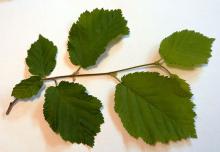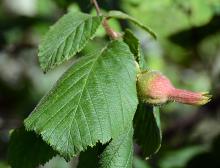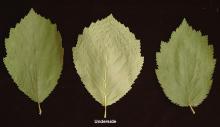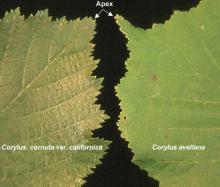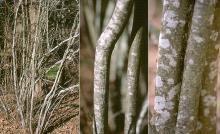Corylus cornuta var. californica
Common name:
Western Hazel
California Hazel
Western Beaked Hazel
Pronunciation:
KO-ril-us kor-NU-ta cal-i-FOR-ni-ca
Family:
Betulaceae
Genus:
Type:
Broadleaf
Native to (or naturalized in) Oregon:
Yes
- Deciduous shrub, open, spreading, multistemmed, 5-12 ft (1.5-4 m) high. Twigs brown, slender, zigzag; trunk bark gray and smooth. Leaves alternate, simple, 4-10 cm long, ovate to obovate, base cordate, coarsely toothed margin, pubescent below. Male flowers in pendent catkins, grouped on the ends of the previous season's twigs, they are 2.4-5 cm long. The female flowers are small, appear as rounded buds with bright red stigmas. Fruit (nut) covered with a involucre (husk), much longer (beak) than the nut it encloses.
- Sun to part shade.
- Hardy to USDA Zone 5 Native range from British Columbia, south along the Coast Range and Cascades and finally further south into the Sierra Nevada of California. In Oregon's Willamette Valley there are some 70,000 acres (2019) of commercially grown European Hazelnut or Filbert (Corylus. avellana) and the nuts are often distributed by birds to natural areas. The resulting shrubs are sometimes confused with the native C. cornuta var. californica.
- One taxonomic orgarization (ITIS) lists the species, Corylus cornuta, as having two subspecies (not var.), C. cornuta ssp. cornuta and C. cornuta ssp. californica. A common name of C. c. ssp. cornuta is Eastern Beaked Hazel; it is a shrub of 4-6 m tall with a fruit 'beak' length 3 cm or more. C. cornuta ssp. californica, Western Beaked Hazel, is larger, 4-15 m tall and with a beak 3 c m or less.
- Native peoples gathered the fruit (nuts) which was eaten fresh or stored for use in winter. Shoots were used in basketry, in making fish traps and even twisted together to make rope.
- cornuta: horned; californica, of California.
Click image to enlarge




